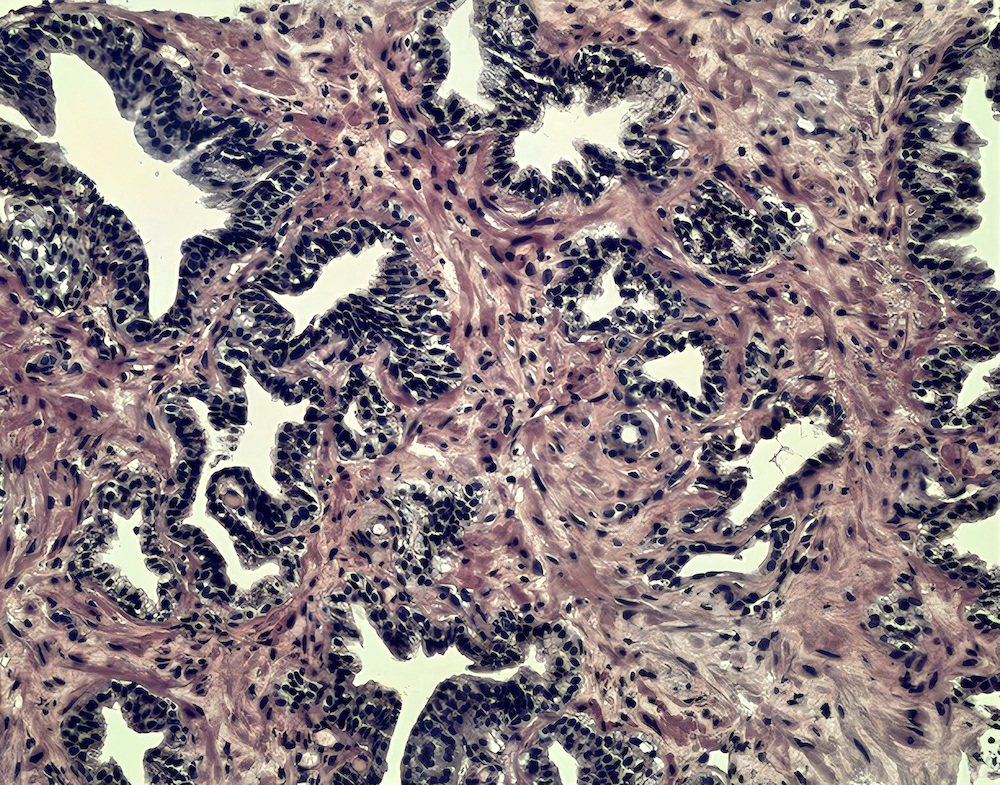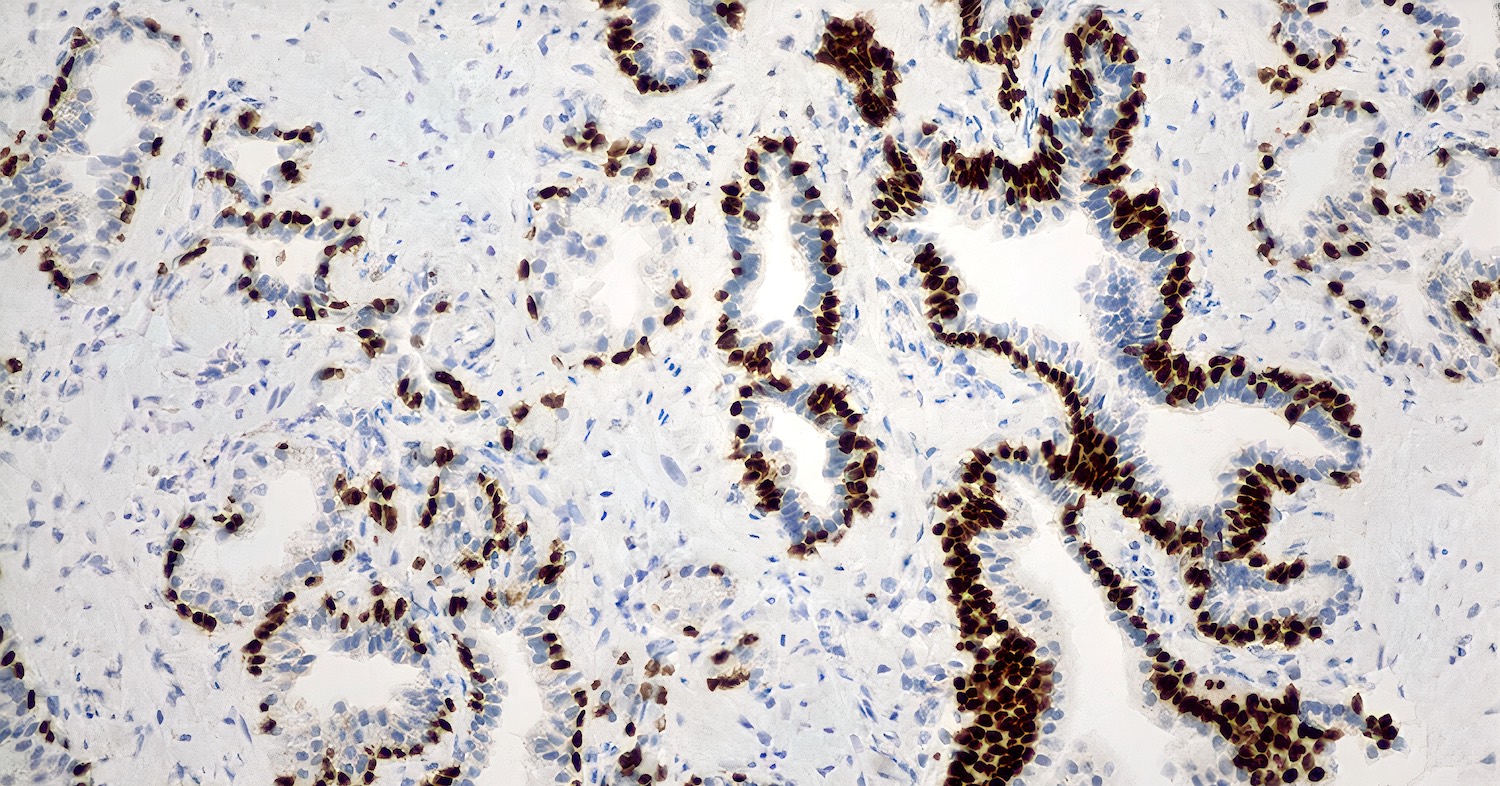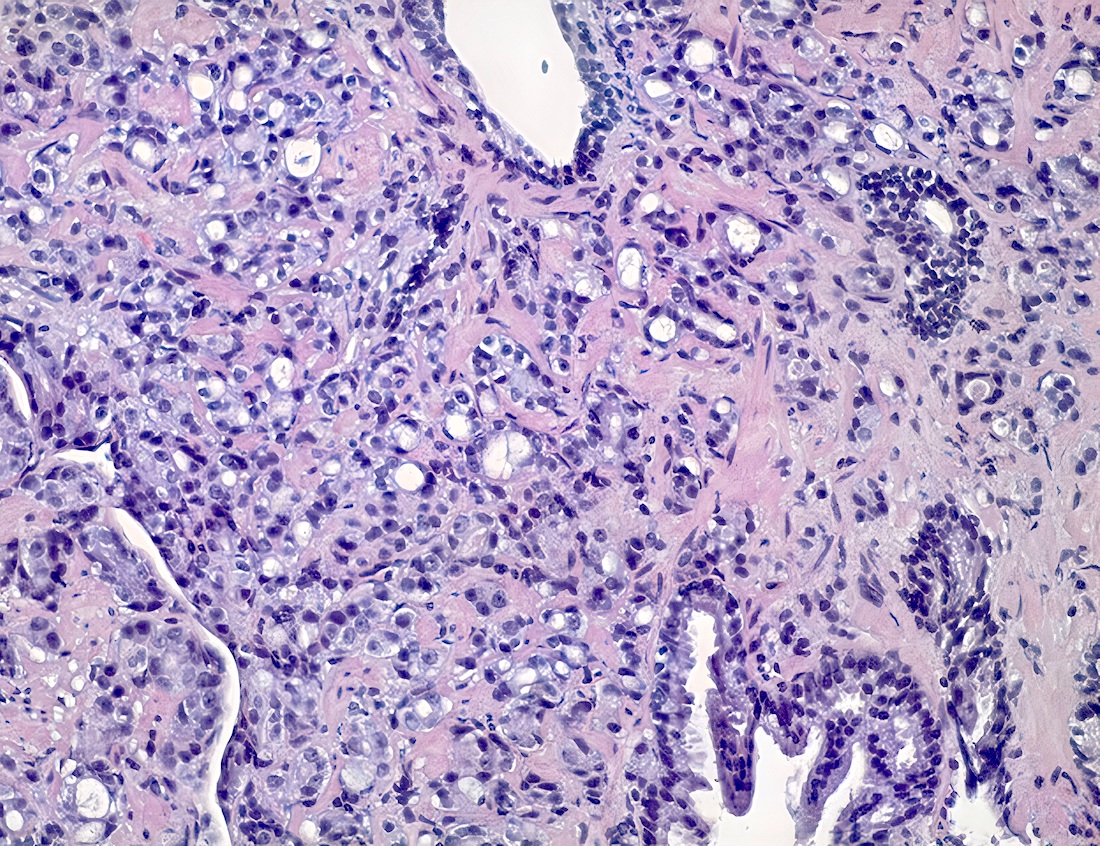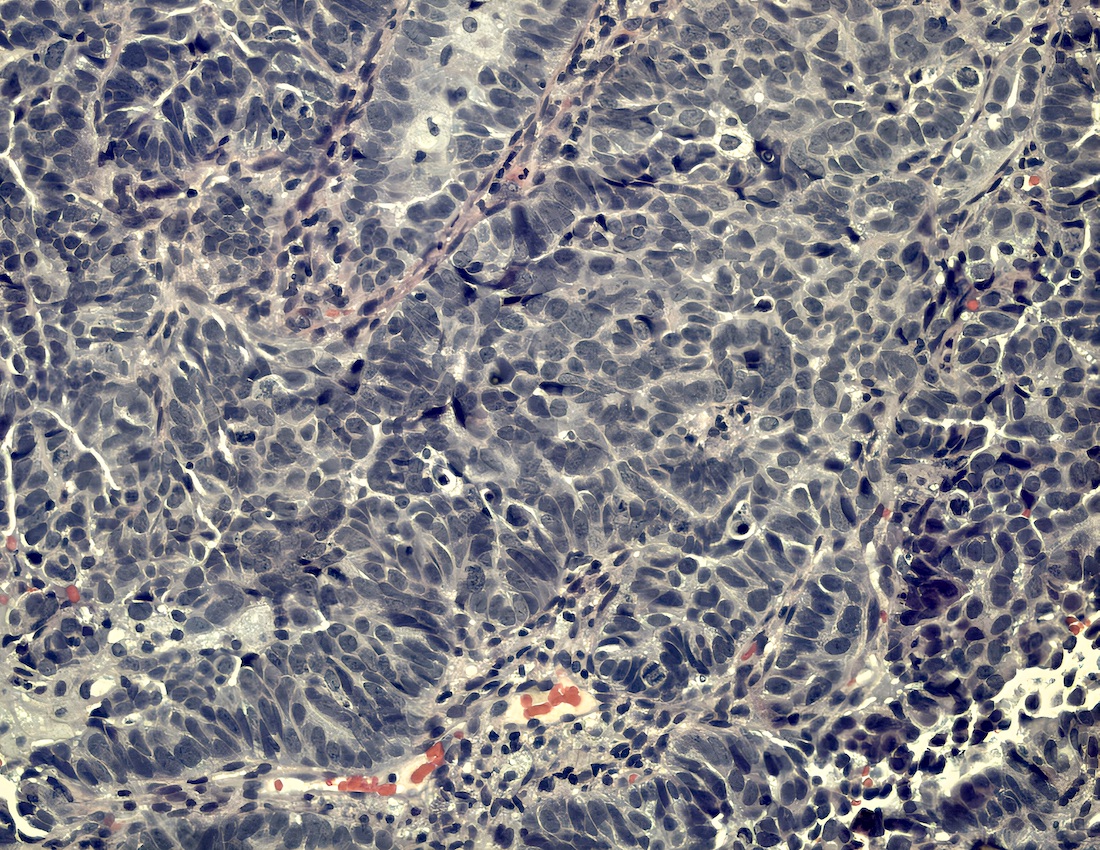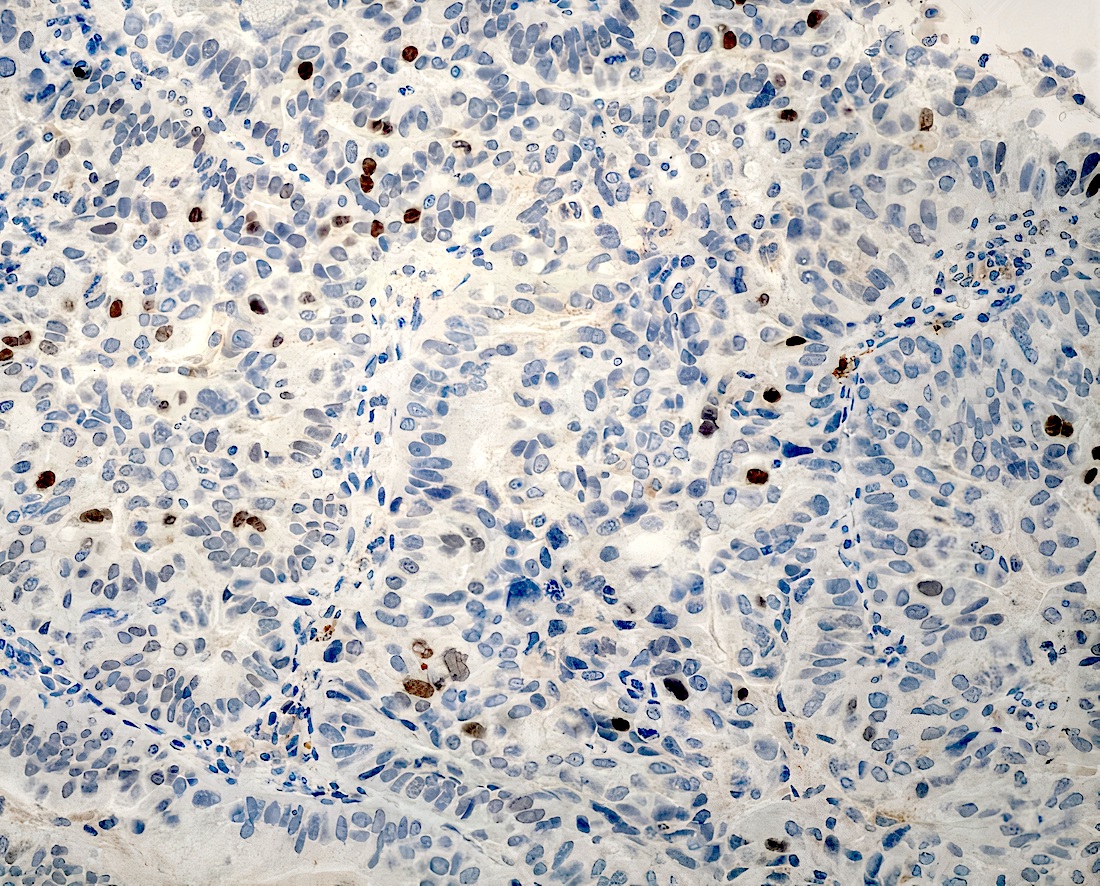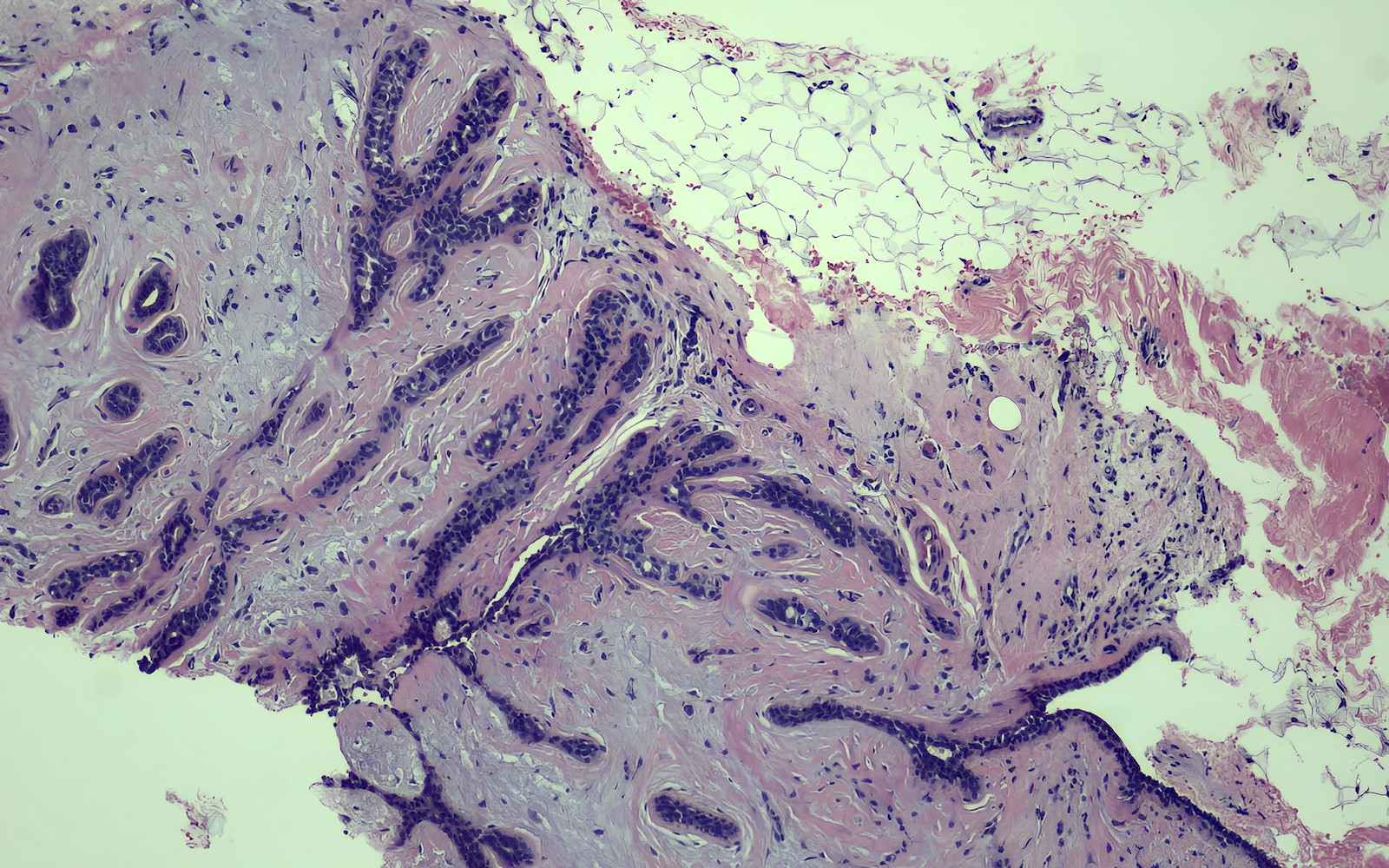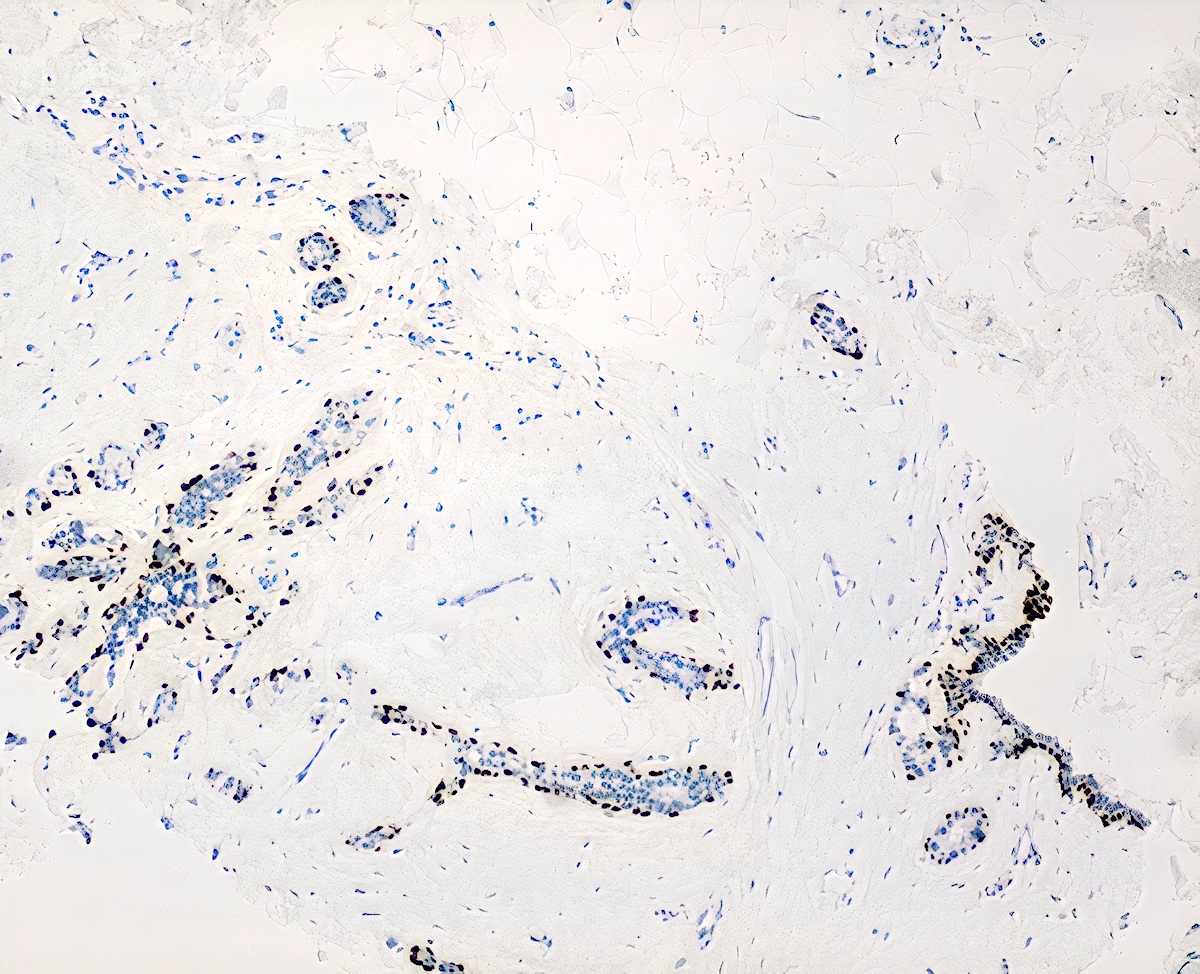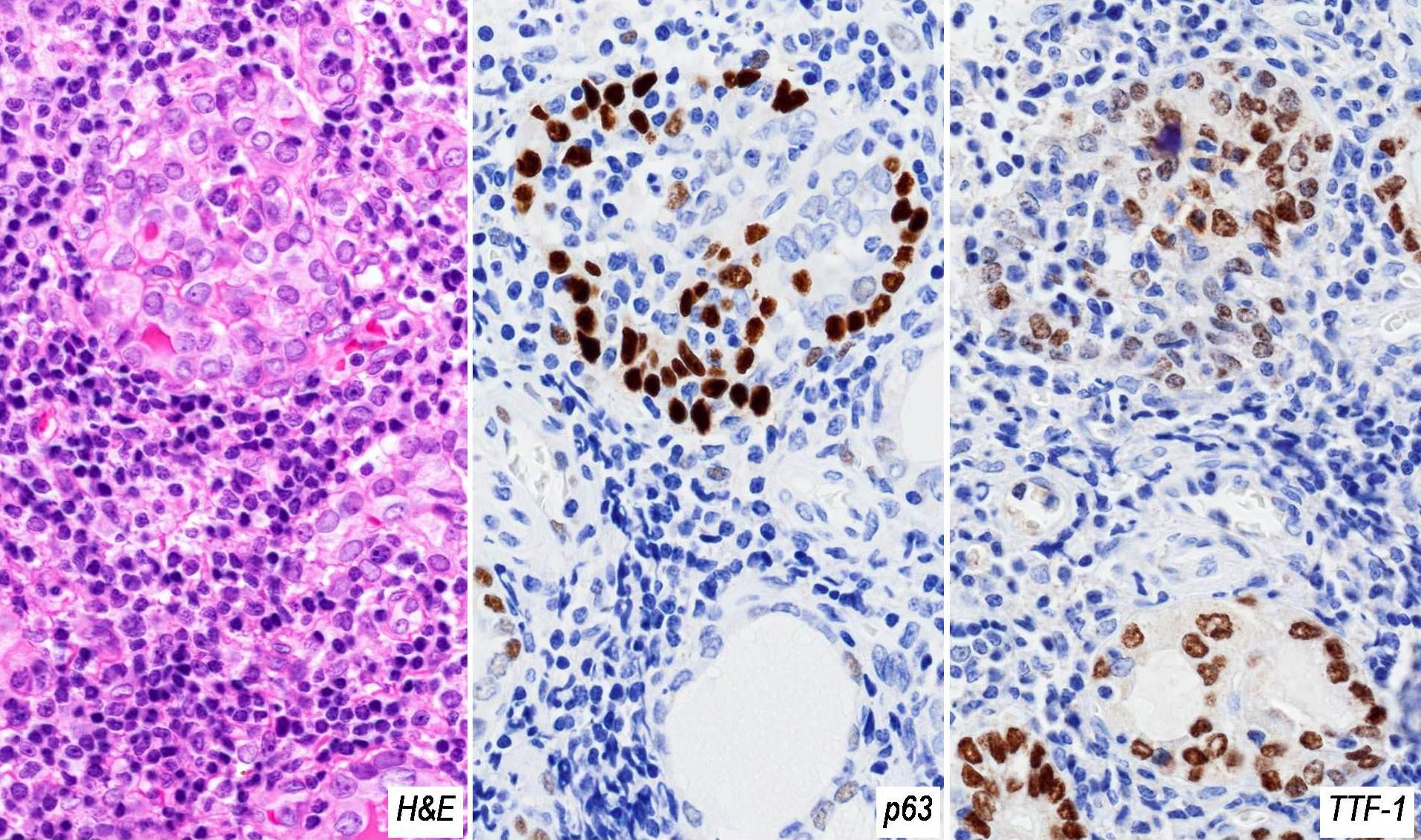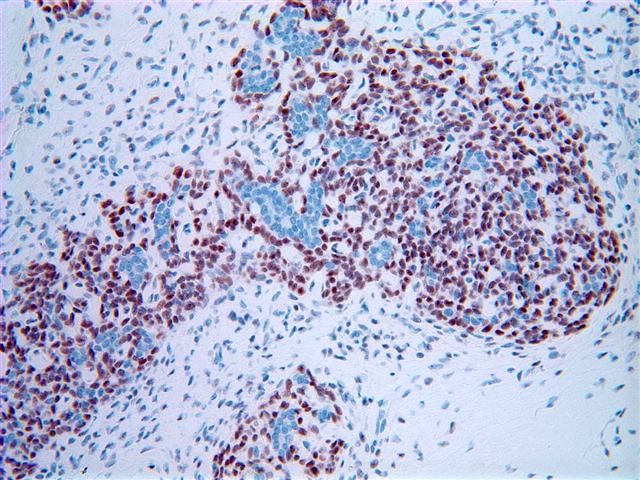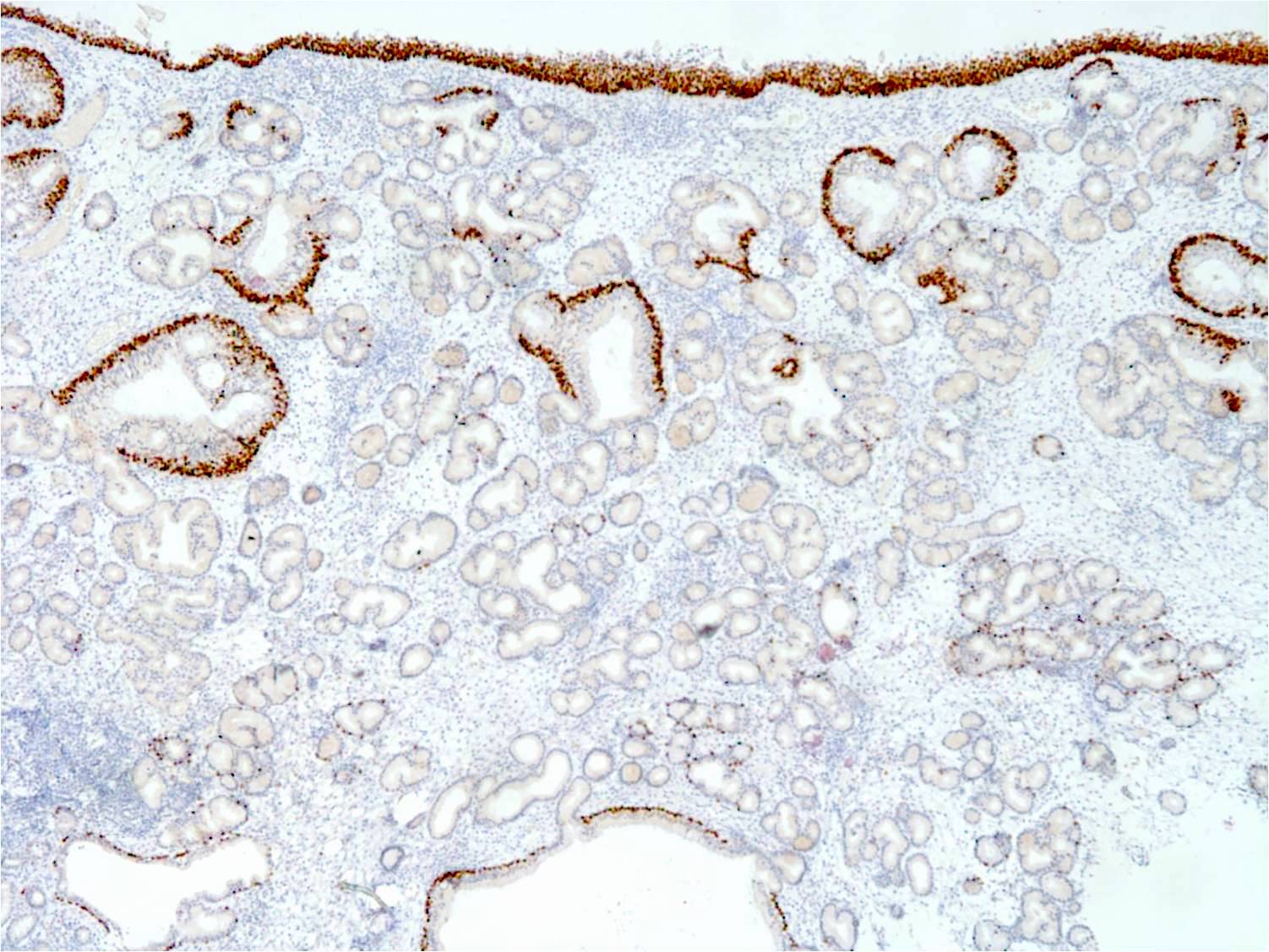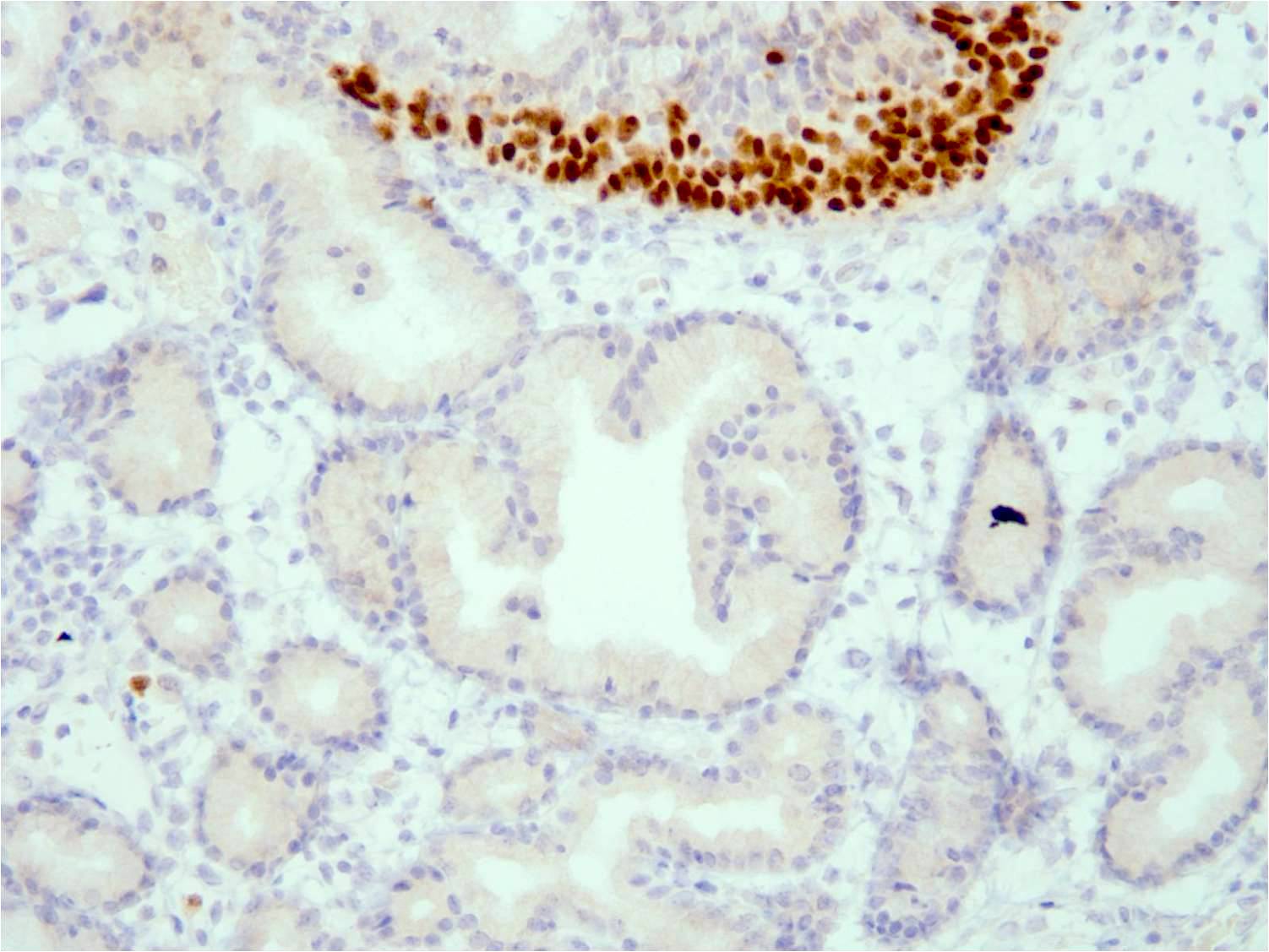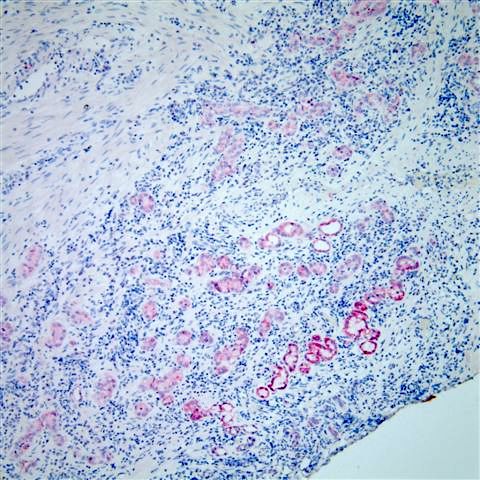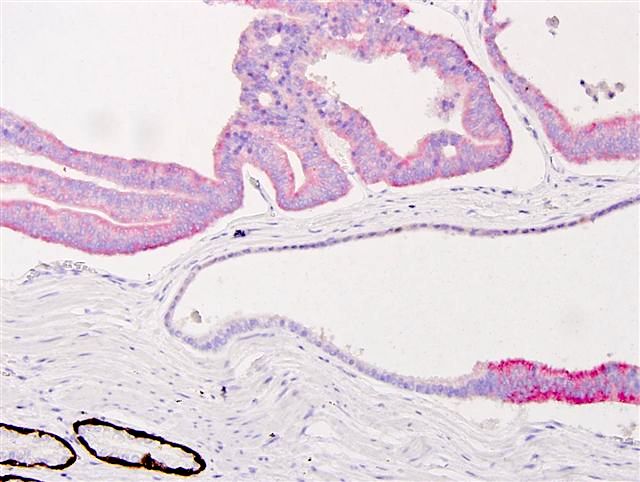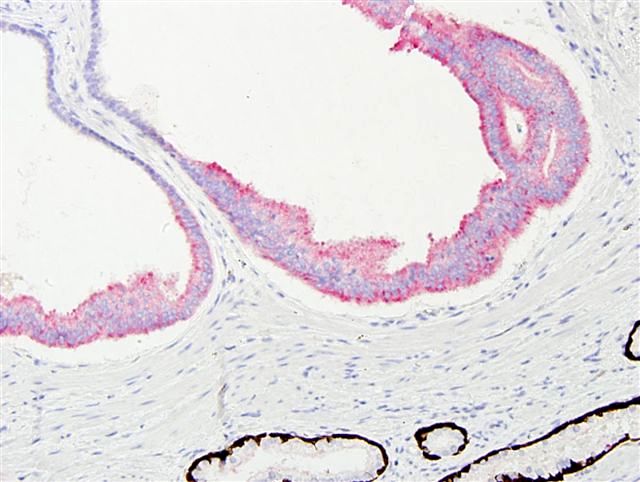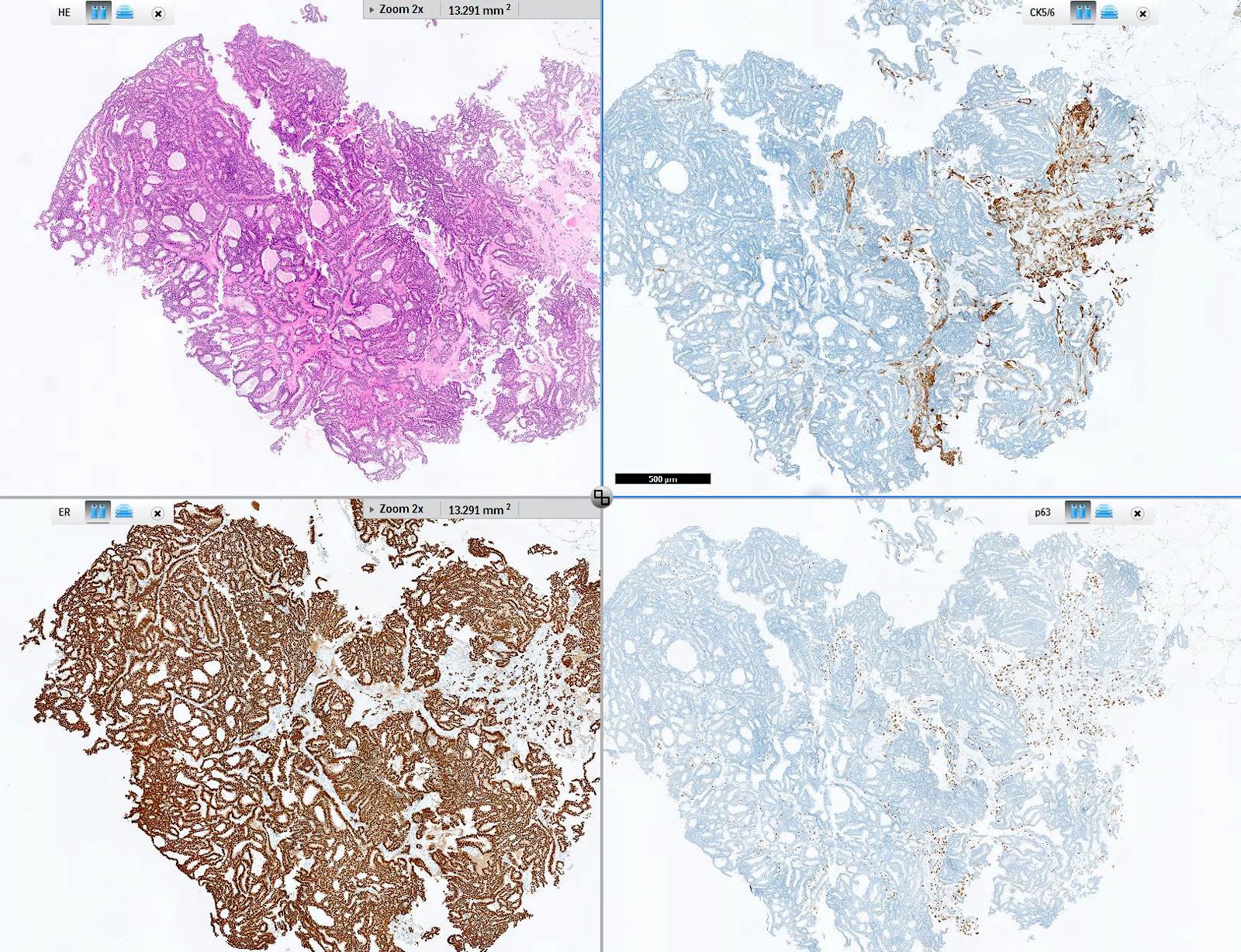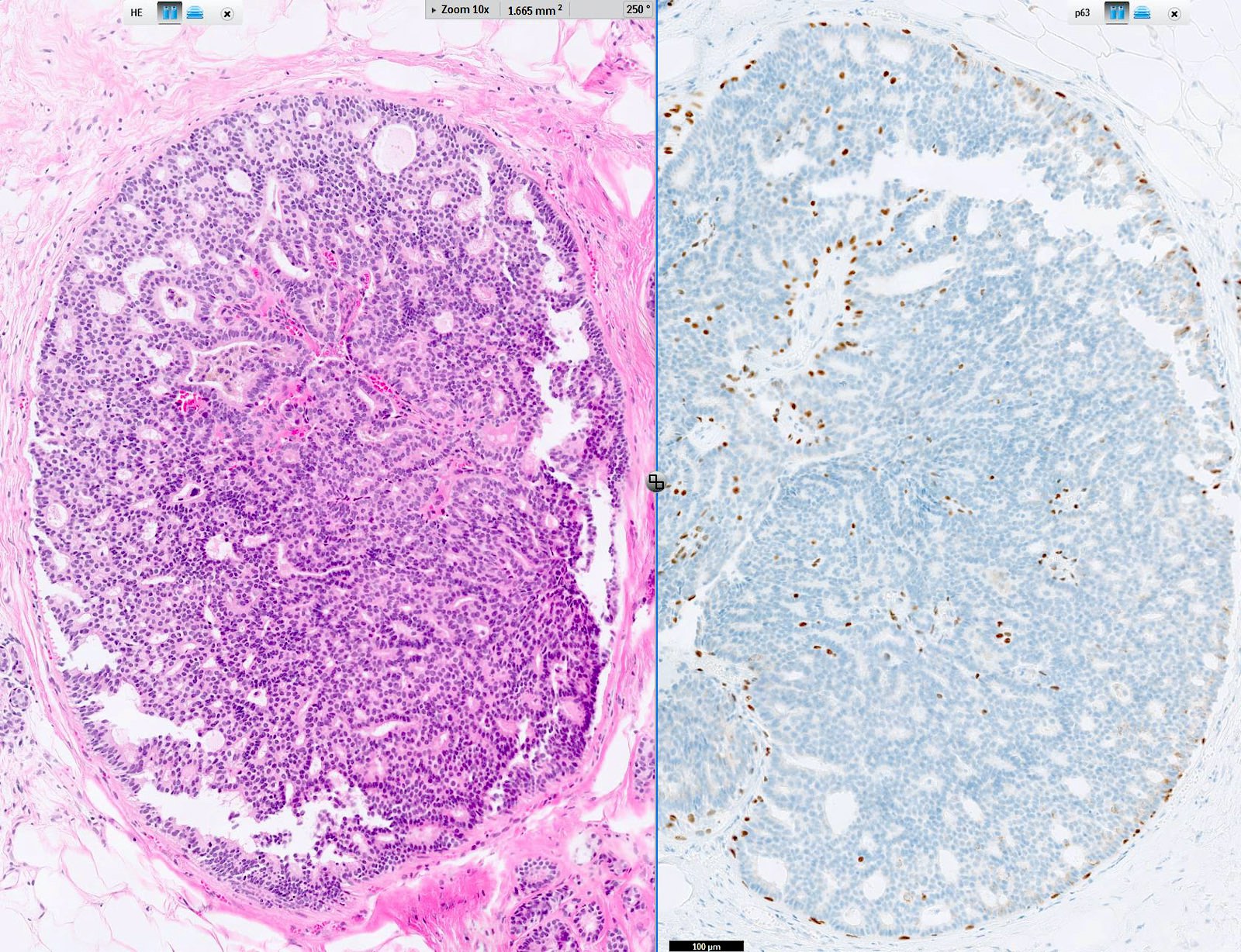Table of Contents
Definition / general | Essential features | Terminology | Pathophysiology | Diagrams / tables | Clinical features | Interpretation | Uses by pathologists | Prognostic factors | Microscopic (histologic) description | Microscopic (histologic) images | Positive staining - normal | Positive staining - disease | Negative staining | Molecular / cytogenetics description | Molecular / cytogenetics images | Sample pathology report | Practice question #1 | Practice answer #1Cite this page: Ismail S, Elshimali JYI. p63. PathologyOutlines.com website. https://www.pathologyoutlines.com/topic/stainsp63.html. Accessed October 1st, 2025.
Definition / general
- Transcription factor that is a member of the p53 gene family
- Master regulator of epidermal keratinocyte proliferation and embryonic epidermal growth
Essential features
- Encoded by the gene TP63 located on 3q27-29 (Mol Cell 1998;2:305, Development 2012;139:772)
- Has more than 6 isoforms
- Marker for myoepithelial cells
Terminology
- Transcription factor
- Known as the guardian of reproduction (Development 2012;139:772)
- Formerly known as keratinocyte transcription factor (KET) in 1997 (Oncogene 1997;15:1363)
Pathophysiology
- Regulates embryonic stem cells development and commitment to epithelial tissue (Genes Dev 2006;20:3185)
- Functions through epigenetic regulation of Satb1, Brg1, Cbx4 and tissue specific chromatin factors (Development 2014;141:101, J Cell Biol 2011;194:825, J Cell Biol 2016;212:77)
- Limb malformation, ectodermal dysplasia and orofacial clefting are associated with p63 germline mutations (Am J Med Genet A 2006;140:1419)
- Multiple isoforms that regulate epithelial growth and development were generated from alternative splicing, including
- TA isoform: the full length and most predominant isoform (BMC Genomics 2015;16:584)
- Has 3 specific exons
- Plays a role in protein interactions through a sterile alpha motif (SAM) domain
- Includes a transactivation domain
- Acts as a transcription factor and a tumor suppressor gene
- Activates BAX, p21 and other p53 target genes
- ΔN isoform: also known as p40 (Mol Cell Biol 2002;22:8601, Development 2012;139:772)
- Was considered an inactive transcription factor
- Inhibits TAP63 isoform
- Essential for epithelial development
- Lacks the transactivation domain TA1
- Shorter than TAP63
- (β) isoform: lacks exon 13, the transcription inhibitory (TID) and sterile alpha motif domains (Nucleic Acids Res 2009;37:6092)
- (γ) isoform: lacks the exons 11 - 14, mainly expressed in muscle cells and cancer-like stem cells (Nucleic Acids Res 2009;37:6092, Mol Cell 1998;2:305)
- ΔΔN isoform: a recently generated isoform, distinct from the ΔN isoform as it lacks its first 26 amino acids in epidermal keratinocytes (Nucleic Acids Res 2009;37:6092, Hum Mol Genet 2008;17:1968)
- (δ) isoform: lacks exon 13
- (ε) isoform: detected first though generation from a stop codon in exon 10 (Nucleic Acids Res 2009;37:6092, Hum Mol Genet 2008;17:1968)
- TA isoform: the full length and most predominant isoform (BMC Genomics 2015;16:584)
Clinical features
- Investigate the primary origin of malignant tumors
- In most cases, p63 can help exclude the diagnosis of invasive adenocarcinomas in the prostate and breast; however, there are exceptions
- Case of prostatic adenocarcinoma in 65 year old man with diffuse, nonbasal p63 staining (Arch Pathol Lab Med 2013;137:1179)
- Low level of p63 staining in tumor cells in 2 cases of metaplastic breast carcinoma (Hamdan Medical Journal 2023;16:278)
Interpretation
- Mainly nuclear
- Could demonstrate cytoplasmic expression in Z bands in skeletal muscle cells (Mod Pathol 2011;24:1320)
Uses by pathologists
- In lung: detects squamous cell carcinoma and differentiates it from adenocarcinomas (J Cytol 2021;38:151)
- In the kidneys: distinguishes urothelial carcinoma from renal cell carcinoma (Hum Pathol 2014;45:1824)
- In the prostate: distinguishes prostatic hyperplasia from well differentiated prostatic adenocarcinoma (Am J Surg Pathol 2002;26:1161)
- In the bladder: distinguishes poorly differentiated urothelial carcinoma from metastatic prostatic adenocarcinoma (J Pathol Transl Med 2016;50:345)
- Favors the diagnosis of sarcomatoid carcinoma over sarcomas in the bladder (Mod Pathol 2005;18:1471)
- In most cases, p63 can help exclude the diagnosis of invasive adenocarcinomas in the prostate and breast; however, there are exceptions
- Case of prostatic adenocarcinoma in 65 year old man with diffuse, nonbasal p63 staining (Arch Pathol Lab Med 2013;137:1179)
- Low level of p63 staining in tumor cells in 2 cases of metaplastic breast carcinoma (Hamdan Medical Journal 2023;16:278)
- Differentiates cutaneous sweat gland carcinoma (p63+) from metastatic breast adenocarcinoma to skin (p63-) (Arch Pathol Lab Med 2011;135:975)
- Differentiates olfactory neuroblastoma (p63- / calretinin+) from other small round blue cell tumors of sinonasal tract (Am J Surg Pathol 2011;35:1786)
- Differentiates renal collecting duct carcinoma (p63- / PAX8+) from upper tract urothelial carcinoma (Am J Surg Pathol 2011;35:757)
- p63 expression can be helpful in identifying primary adnexal neoplasms versus other metastatic processes (J Cutan Pathol 2007;34:474)
Prognostic factors
- Loss of p63 expression correlates with poor prognosis in urothelial carcinoma, squamous cell carcinoma of the esophagus and larynx (Hum Pathol 2014;45:1824, Oncol Rep 2006;15:323, ORL J Otorhinolaryngol Relat Spec 2010;72:319)
- p63 expression is associated with poorer prognosis for Merkel cell carcinoma (Mod Pathol 2011;24:1451)
- Identifies false lymphatic invasion (tumor cells surrounded by D2-40+ / p63+ ducts), which has a good prognosis (Mod Pathol 2011;24:502)
Microscopic (histologic) description
- Nuclear marker for myoepithelial cells in benign tumors and noninvasive malignancies
Microscopic (histologic) images
Positive staining - normal
- Squamous epithelial cells (Biomark Res 2021;9:7)
- Thymic epithelial cells (Biomark Res 2021;9:7)
- Urothelium (Biomark Res 2021;9:7)
- Basal cells of the respiratory tract (Biomark Res 2021;9:7)
- Basal cells of prostate (Biomark Res 2021;9:7)
- Basal cells of seminal vesicle (Biomark Res 2021;9:7)
- Gynecologic tract: basal and parabasal cells of mature cervical, vaginal and vulval squamous epithelium; cervical reserve cells at transformation zone, immature metaplastic and atrophic cervical squamous epithelium (J Pathol Transl Med 2015;49:450)
- Myoepithelial cells in breast (Am J Surg Pathol 2001;25:1054)
- Myoepithelial cells in parotid, submandibular and sublingual glands (Biomark Res 2021;9:7, Clin Cancer Res 2002;8:494)
Positive staining - disease
- In the skin: squamous cell carcinomas, basal cell carcinomas (Biomark Res 2021;9:7)
- Primary cutaneous adnexal neoplasms (with the exception of primary mucinous carcinoma in most cases)
- Tumors of the head and neck: squamous cell carcinoma of the larynx / oral cavity, pleomorphic adenoma of the parotid gland, Warthin tumor (Biomark Res 2021;9:7)
- Tumors of the mediastinum: thymoma (in 65%) (Biomark Res 2021;9:7, Clin Cancer Res 2002;8:494)
- In the lung: identification of squamous cell carcinoma, mainly the specific isoform p40 ΔNp63 (PLoS One 2010;5:e12209, Mod Pathol 2012;25:405)
- Tumors of the female genital tract: squamous cell carcinoma of the vagina / vulva / cervix, Brenner tumor (Biomark Res 2021;9:7)
- Sarcomatoid carcinoma of the breast (Histopathology 2003;42:94)
- Tumors of the digestive system: squamous cell carcinoma of the esophagus / anal canal
- Tumors of the urinary system: urothelial carcinoma (Hum Pathol 2014;45:1824)
- Mild expression in diffuse large B cell lymphoma, follicular lymphoma and chronic lymphocytic leukemia (Appl Immunohistochem Mol Morphol 2005;13:237, Cancer Sci 2006;97:1050, J Clin Pathol 2009;62:77)
- ALK negative ALCLs can express p63, which is associated with TP63 rearrangements (Hum Pathol 2017;64:19)
Negative staining
- Anus: anal gland carcinoma (Arch Pathol Lab Med 2007;131:1304)
- Breast: normal epithelium, stromal cells, myofibroblasts; may be reduced or occasionally absent in benign apocrine lesions, benign sclerosing lesions (Am J Surg Pathol 2011;35:202, Histopathology 2016;68:1030)
- Malignant mixed Müllerian tumors, endometrioid carcinoma, pancreatic, colorectal and cholangiocellular carcinoma (10 - 25%) (Proc Natl Acad Sci U S A 2013;110:8105, Oncotarget 2017;8:22741)
- Melanoma (Am J Surg Pathol 2012;36:1216)
- Mesothelioma
- Prostate: adenocarcinoma, nephrogenic adenoma, partial atrophy (Am J Surg Pathol 2012;36:1216)
- Most soft tissue tumors (Am J Clin Pathol 2011;136:762)
Molecular / cytogenetics description
- Encoded by the gene TP63 located on 3q27-29
- Multidomain protein with more than 6 isoforms
- Isoforms are generated through alternative splicing at the 3 site
- Tetramer that has a DNA binding domain (DBD), an N terminal transcactivation domain (TA), a tetramerization domain (TD) and a transcription inhibitory domain following C terminal sterile alpha motif (SAM) (Mol Cell Biol 2002;22:8601, Mol Cell 1998;2:305)
Molecular / cytogenetics images
Sample pathology report
- Prostate, core needle biopsy, measuring 2 x 1 x 1 cm and tan-brown in color:
- Benign prostatic hyperplasia (see comment)
- Comment: Microscopic examination of the biopsy revealed the proliferation of prostatic glands lined by epithelial cells with no signs of atypia in the lining of epithelial cells. Immunohistochemistry demonstrated a strong nuclear expression of p63 in the basal cells of the hyperplastic glands. These features correlate with benign prostatic hyperplasia.
Practice question #1
Practice answer #1
B. Loss of p63 expression correlates with poor prognosis in urothelial carcinoma. Answer A is incorrect because p63 has more than 6 isoforms. Answer C is incorrect because p63 is a marker for squamous epithelial cells. Answer D is incorrect because p63 is a marker for basal epithelial cells.
Comment Here
Reference: p63
Comment Here
Reference: p63





